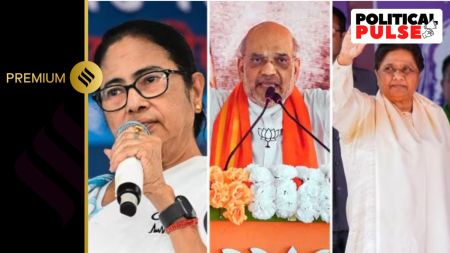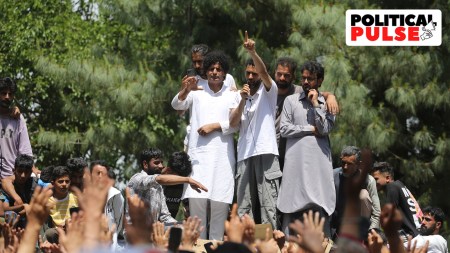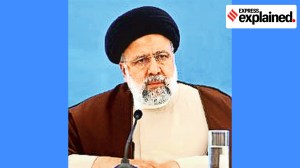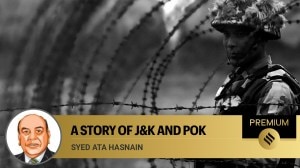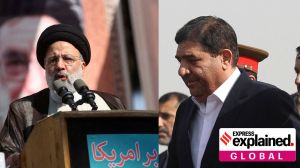- India
- International
The fine print in the Indo-US pact, iCET
The initiative could catalyse Indo-US technology cooperation by persuading Washington to lift existing export control restrictions, and encouraging the private sector of both countries to cooperate in sensitive sectors including defence. But Atmanirbharta must remain India's ultimate aim
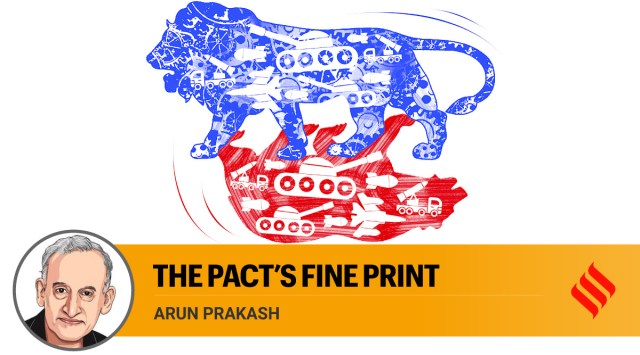 While India is in dire need of technology, the US industry remains firmly focused on trade. India will, therefore, need to leverage its considerable purchases in the arms, energy, civil aviation, nuclear and other sectors in a holistic manner to extract technology from the US. (Illustration: C R Sasikumar)
While India is in dire need of technology, the US industry remains firmly focused on trade. India will, therefore, need to leverage its considerable purchases in the arms, energy, civil aviation, nuclear and other sectors in a holistic manner to extract technology from the US. (Illustration: C R Sasikumar) In his 2019 book, The Hundred Year Marathon, Michael Pillsbury, a foreign policy strategist, who has held positions in the US administration and Senate, says, “…not only has China’s rise happened right under our noses, but also the US and the West have helped the Chinese accomplish their goals from the beginning… For decades, the US government freely handed over sensitive information, technology, military know-how and expert advice to China.” Ominously, he adds, “The American public is unaware of the extent of covert cooperation between Washington and Beijing over the past forty years.”
If Pillsbury’s account is to be believed, the dramatic ascent of a prosperous, technologically advanced and militaristic China — leaving India far behind in its wake — owes much to the close multidimensional cooperation extended to it by the US since the 1980s. In which case, the recent unveiling of a US-India Initiative on Critical and Emerging Technologies (iCET) comes half a century too late for India. Seen in the light of President Biden’s 2021 undertaking to transfer multiple advanced technologies, including submarine nuclear propulsion to Australia, it starkly highlights the absence of any significant offer of high tech by the US to India, despite bilateral ties, growing steadily in warmth and closeness.
There has, however, been no dearth of accords and agreements, with lofty titles, framed to enhance Indo-US cooperation in the security and technology domains. Some examples: “Next Steps in Strategic Partnership” in 2004; “Defence Framework Agreement” in 2005: the pathbreaking “Indo-US Civil Nuclear Agreement” in 2008; launching of the “Defence Technology and Trade Initiative” in 2012; accord of “Major Defence Partner” status by US Congress in 2016; and institution of “2+2 talks” in 2018. The signing of the fourth and last of the key “foundational agreements” in 2020 was supposed to have eliminated the final impediment to closer security cooperation. However, after nearly two decades of this pretentious “pas de deux”, all that the Indo-US “strategic partnership” had delivered was $22 billion worth of military hardware, purchased by India via the foreign military sales programme.
In a determined bid at the highest level to address this state of stasis, a communique following the May 2022 Biden-Modi quadrilateral summit in Tokyo announced “the launch of a US-India Initiative on Critical and Emerging Technologies spearheaded by the National Security Councils (NSC) of the two countries”. Following this, a team of top Indian scientists, including the heads of ISRO and DRDO, recently held the first formal talks in Washington with their US counterparts; both teams being led by respective NSAs.
Pitched at the exalted level of the two NSCs, the iCET could become a “game changer” in catalysing Indo-US technology cooperation by persuading the US to lift existing export control restrictions, and encouraging the private sector of both countries to cooperate in sensitive sectors. The most important outcome, however, would be to dispel the cloud of mistrust that has hung over this relationship and to demonstrate a mutual commitment to investing in advanced technologies, such as quantum computing, AI and space, as well as the critical field of semiconductor design and manufacture.

While many of these emerging technologies have huge future potential, both in the civil sector and the security domain, there are other areas — less esoteric but equally important — in which India’s defence industrial complex has been struggling for decades and on which iCET must focus urgently.
This issue is best illustrated by citing the cautionary tale of the six-decade-long association of India’s massive defence industrial complex, comprising the DRDO, defence public sector undertakings (DPSU) and the (erstwhile) Ordnance Factory Board, with the Soviet/Russian arms industry. Commencing in the mid-1960s, our DPSUs built, under licence, 800 or more fighters of the MiG series along with about 2,000 aero engines as well as a few thousand battle-tanks, armoured vehicles and their engines.
While the DPSUs consistently claimed transfer of technology (ToT) in the process of licenced production, the fact is Indian engineers and designers acquired only the “knowhow” of methods and procedures required for assembling or building aircraft, aero engines and armoured vehicles from parts or material supplied. We neither asked nor were offered (by the Soviets/Russians) the “know-what” and “know-why” involving the principles and laws that would have enabled us to design and build our own weapon-systems. As a direct consequence of this oversight or lapse, India has remained amongst the world’s largest importer of arms; buying from abroad weapons ranging from rifles and machine guns to battle tanks and fighters, and prime movers from diesel and aero engines to nuclear reactors.
While the iCET promises a long overdue transformation, four aspects demand wariness on India’s part. First, even though ownership of technology in the US may lie with the private sector, the US Arms Export Control Act not only requires clearances from the Departments of State and Defence for ToT but also imposes certain restrictions on the recipient state.
Second, an unstated but significant, long-term objective of the iCET is, surely, to wean India off its dependency on Russian military hardware. This is likely to face stiff resistance on various grounds from Moscow as well as from domestic quarters, but national interest must prevail. Over the past 60 years, neither the quality of Soviet/Russian hardware nor the product support has ever matched that of its western counterparts, and the disruption caused by the Russia-Ukraine conflict will further aggravate the situation. The time has come for India to break free of Russia’s apron strings and regain “strategic autonomy” in international affairs.
Third, while India is in dire need of technology, the US industry remains firmly focused on trade. India will, therefore, need to leverage its considerable purchases in the arms, energy, civil aviation, nuclear and other sectors in a holistic manner to extract technology from the US.
Finally, we must bear in mind that merely switching from Russian to American military hardware will be a case of “jumping from the frying pan into the fire”. Atmanirbharta must remain our ultimate aim.
The writer is a former naval chief
EXPRESS OPINION
Must Read
More Explained
May 21: Latest News
- 01
- 02
- 03
- 04
- 05






